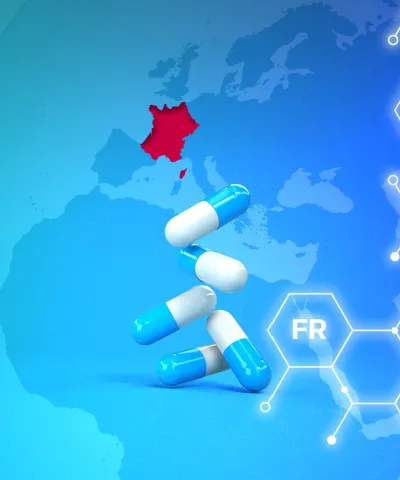*The insights and recommendations shared in this article are based on the circumstances as of May 20, 2020
COVID-19 is a wake-up call for the life science industry and its policy makers. Social distancing measures have canceled face-to-face customer engagement, and digital alternatives are not yet up to par. But how can they get there? Even though customer engagement models are multi-dimensional with a variety of different levers, in this article, we will zoom in on the accelerated digitalization of product and service offering as well as on sales and marketing channels.
As we all know, COVID-19 has shaken the business world, and the life sciences industry especially. Social distancing measures rule out traditional face-to-face engagement models and interaction between patients, physicians, payers, and manufacturers. In the past, digital alternatives have been slowly driven by C-levels and hampered by policy makers. Now, within days, COVID-19 has put digital interaction and remote sales on the agenda in every field, with life sciences being no exception. How do companies launch initiatives like these? As the question isn’t when we will get back to “normal”, but rather how to deal with a challenging situation for the unforeseeable future, we need to find out how COVID-19 has changed permanently the industry’s customer engagement model. We focus on how to accelerate the digitalization of your product and service offering as well as on how to launch the accompanying necessary sales and marketing channels.
DIGITAL PRODUCT & SERVICE OFFERING
Digital product and service offerings bridge social distancing measures
Customer needs have changed due to social distancing measures and clinical safety precautions. There is a steep increase in demand for digital product solutions requested by physicians and patients. Especially in chronic care (e.g. COPD, asthma, diabetes, and mental health) we observe a strong push by care providers in the inpatient and outpatient setting for remote patient management.
In the past, continuous glucose monitoring (CGM) has been almost exclusively applied in the outpatient setting. But with the surge of COVID-19 and the need to reduce physical contact to patients, the FDA has permitted Dexcom and Abbott, leading providers for CGM, to provide CGM sensors for the in-clinic use. These sensors are linked to patient apps and HCP portals for remote patient management. So it is not surprising that Dexcom’s share price is up 40 percent in April.
We also observe a strong interest increase in digital therapeutics. Digital therapeutics are software/app-based therapies backed up with evidence on clinical efficacy. They are easy to scale and do not require any face-to-face interactions. Especially in chronic diseases we see raising stars accelerated by COVID-19. Livongo (a digital therapeutics company for diabetes) has experienced a 70 percent share price increase since April first. In the US, the FDA has introduced a fast track approval process for digital therapeutics targeting mental health and psychiatric conditions. In addition, Omada Health has announced to provide free access to their mental health offering for six months. This will assumingly lead to a robust paying customer base, once the six months free trial are over. These are only selective examples out of an entire cohort of rising stars that fully leverage digital product offerings and interaction channels to benefit from the COVID-19 environment.
On the service side we also see that customer openness for digitalized service elements has increased. Live support via videos streaming (e.g. pacemaker implantation) has been widely applied for elective procedures (that have not been postponed) and complex emergency cases. Instead of having a therapy specialist physically in the room, that same specialist can now attend remotely multiple procedures on the same day, boosting efficiency gains and minimizing physical exposure. Even though customers have initially been sceptical on the quality of remote services like these, they quickly adopted the digitalized service offerings.
The most prominent surge in patient and physician demand for digital service solutions has surely been for telemedicine solutions. Whereas the technical infrastructure for telemedicine has been ready for more than a decade, the patient acceptance and uptake was low. That changed rapidly when social distancing measures were put in place and patients suddenly developed an increasing openness for telemedicine. Solv, a telemedicine platform provider, saw an increase of 3,400 percent in teleconsultation bookings in March alone.
Customers’ risen acceptance for digital products and services will continue
Due to a lack of physical alternatives, COVID-19 has cracked customers’ and policy makers’ skepticism towards digital offer elements. In the past weeks, customers have experienced efficiency gains at the same care quality, implying that most initially short-term COVID-19 digital product and service features will be advanced in the future. Heather Fernandez, CEO and co-founder of Solv sums up: “In this moment, consumers are experiencing telemedicine and discovering the ease by which they can receive quality care; providers are overcoming their concerns; and payers are aligning reimbursement so that physicians can actually get compensated for the work that they do. Given the acceleration of telemedicine in this moment, this shift will take hold and fundamentally transform healthcare for all of us.”
Along the patient journey, starting from initial diagnosis to post-op care, companies need to identify digital product features and service elements that add meaningful patient, physician, or payer value. Digital features provide an agile response opportunity for companies to quickly adapt products to new market dynamics and directly engage with customers.
SALES ENGAGEMENT
Sales engagement: Remote sales have picked-up across the industry
Medical devices usually require extensive explanations, beta testing (big capital equipment), and hands-on product demos. It is not surprising that these products have been sold via an outside field force in the past. Similarly, we see that pharmaceutical companies have established extensive field sales to push their drugs and encourage physicians to prescribe their products. In the current situation, field sales forces are forbidden to visit on-site, therefore, the traditional sales engagement channel is seriously challenged for the first time.
Unlike field teams, remote sales and service teams are not affected significantly by the restrictions of social distancing. They can reach out to target customers remotely through e-mails, phones, or video. Supporting materials (e.g. educational webinars, electronic product brochures, clinical evidence) can also be easily provided via digital channels, rather than delivering them in-person. So we see in the market that most pharma companies have started to pitch their product remotely to physicians. After Eli Lilly received FDA approval for a new oncology drug for thyroid and lung cancer on May 8th, Eric Dozier, vice president of North American oncology for Lilly ensured that within days the drug will be remotely pitched to physicians: “We have a responsibility to make sure we inform doctors, given that cancer is not going to take a break during the COVID-19 pandemic”.
In addition to remote sales, in other industries, we have seen the rise of B2B e-commerce. In the life sciences industry, some pharmacies have already completed the shift to e-commerce. With e-prescriptions slowly being established by lawmakers, e-commerce adoption by pharmacies and among pharma companies will gain an extra boost. For MedTech companies, especially high runners and low-complexity products have been channeled through virtual procurement and e-commerce platforms.
Cost savings and soft gains will lead to a permanent shift towards remote sales
For sure, bridging social-distancing measures is the key benefit of remote sales during the COVID-19 crisis. But there are additional economic and qualitative benefits:
- No travel expenses and corporate cars are required, leading to direct cost savings.
- The reduction in travel time enables sales to refocus on actual sales activities.
- Sales reps feel empowered to restructure their daily routine and increased the overall job satisfaction and attractiveness.
- The mitigation of geographic constraints expands the pool of prospective recruiting candidates and potential new customers.
In a first step, companies need to assess which products in the portfolio can be transitioned to a remote sales force beyond the COVID-19 crisis. Second, companies need to evaluate what resources and trainings are required as well as how much potential there is for downsizing the outside sales team.
OMNI CHANNEL COMMUNICATION
Tailored digital marketing campaigns are not effected by COVID-19
Out of the three discussed engagement model dimensions, the customer communication is surely the one that has been most advanced in terms of digitalization in the past. Besides KOL engagements, best-in-class life science companies have targeted physicians and patients with tailored marketing campaigns to raise product awareness and push sales. Due to COVID-19, conferences and trade fairs are cancelled, which are established key contact points to address larger audiences of physicians and patients.
Digital marketing and communication is the critical channel that has not been crippled by COVID-19. With limited access to physicians, patients have accelerated their online self-education and we see a steep uptake of online patient education material provided by manufacturers. Also, for physicians, we see that product launches and trainings have been either postponed or been conducted via virtual meetings.
For digital health solutions that directly target patient’s communication and interaction has moved completely onto digital channels, via apps, blogs, and dedicated product websites. In orthopedics, we see that major players like Johnson & Johnson provide digital educational and coordination support for patients and surgeons along the entire care pathway solutions.
Even payer and market access authority communication has moved from the offline into the online world. For example the UK NICE technology appraisal committee meetings are conducted online and manufacturers can join in as commentators. Similar in the pharma industry, we see that KOL advisory boards have been set-up as remote meetings.
Interacting digital and offline marketing measures need to personalize content for patients and physicians
Even prior to COVID-19, omni-channel marketing has proven to drive customer awareness and boost sales. During the crisis, we have seen a strong shift towards online marketing. Best-in-class manufacturers have linked offline and online communication measures to create personalized and tailored marketing campaigns for patients and physicians, leveraging insights from social media and historic buying patterns.
To achieve similar results, companies first need to understand from which channels payers, physicians, and patients derive their information. Secondly, life sciences firms have to define how offline and online communication should interact with each other, leveraging e-mail newsletters, online webinars, customer portals, social media campaigns, and patient or physician apps. Thereby it is important to target payers, physicians, and patients along the care pathway.
7 KEY STEPS TO SHAPE YOUR DIGITAL CUSTOMER ENGAGEMENT MODEL
COVID-19 has disrupted outdated engagement models and provided an opportunity for rising stars with agile new approaches to interact with customers. The outbreak became a turning point for companies and healthcare providers who have hesitated to steer a digital strategy and drive the digital transformation. Based on best-in-class industry examples, we have compiled a list of seven key steps to accelerate the digitalization of your customer engagement model along the customer journey:
- Understand the customer journey of payers, physicians and patients and how they access information.
- Assess your current portfolio communication and sales model at each touch-point along the journey.
- Evaluate gaps of communication and product/service offering prior to COVID-19 and after the enforcement of social distancing measures.
- Identify white spots and new digital measures (product and services, communication, and sales touchpoints) to accelerate customer interaction throughout the journey.
- Build internal capabilities and develop business case to prioritize opportunities.
- Validate opportunities with payers, patients, and physicians.
- Refine and roll-out.
These 7 steps will not only accelerate the digitalization of your customer engagement model and provide direct top- and bottom line impact but will also reduce the downside risks of resurging crises.








